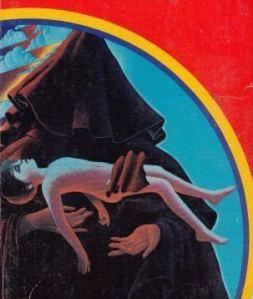The last man on Earth sat alone in a room. There was a knock on the door… - Fredric Brown
As I’ve said many times, I prefer short stories to novels; even when I shared my list of favorite books a year ago, six of thirteen were short story collections. As I said then, “This is because for me, a large part of the pleasure of a book is the mood it sets, and if that mood is disturbed I can’t enjoy it nearly as much. Short stories are quickly consumed, and even novellas or short novels can be read in one extended sitting…When I started whoring the long-established preference for short fiction grew even stronger, because I knew that at any moment I might be interrupted by a phone call from a client and have to run off.” But despite this preference (or perhaps because of it), choosing a list of favorite short stories was even more difficult than choosing my favorite books. Last May Eve I provided my list of the ten scariest short stories, and I’ve excluded those from this list along with all stories which are included in any of my favorite books (which means everything by Doyle, Lovecraft and Poe). I also excluded fairy tales because, though I love them dearly, they’re really a different genre (and one I will visit in a future column).
Because most of these are quite well-known and highly regarded, and none of them were published after I was born, I was able to secure PDFs of all but two. There was a PDF of #7 as well, but it was so poorly formatted that the ends of most lines were cut off on the right side; I therefore decided not to provide it, but if someone can locate a proper copy I will. You will note the majority of these are quite short; three of them qualify as short-shorts, and only two are novelettes. But since y’all know my own fiction is primarily in the short-short format, that shouldn’t surprise you. All of these are either fantasy, science fiction, horror or suspense except for #3, which is essentially psychological horror (as is #5). They all have something else in common: all are unique and highly memorable. They are listed here in chronological order.
1) “Rappaccini’s Daughter” by Nathaniel Hawthorne (1844)

2) “How Much Land Does A Man Need?” by Leo Tolstoy (1886)
Though he is best known in the English-speaking world for his lengthy novels War and Peace and Anna Karenina, Tolstoy also wrote many fine short stories including this fine example of the subgenre the French refer to as contes cruels, stories which are not necessarily supernatural but demonstrate the cruelty of fate and usually conclude with a shocking or horrifying twist. John Collier and Roald Dahl (see below) also produced many tales of this type.
3) “Heart of Darkness” by Joseph Conrad (1899)

4) “Sredni Vashtar” by Saki (1914)
Saki was the pen name of H.H. Munro, a brilliant British author whose career was cut short by a German sniper at the Battle of the Ancre in 1916. His best work is equal parts horror and humor, and this one – the story of a sickly orphan who creates his own secret pagan cult in his guardian’s shed – is its perfect exemplar.
5) “Silent Snow, Secret Snow” by Conrad Aiken (1934)
This chilling (no pun intended) tale of a young boy’s descent into madness manages to create a horrifying atmosphere without any of the conventional elements of horror. In addition to the PDF, I thought y’all might enjoy this short film made for TV in 1966; the same director later remade it as an episode of Night Gallery, narrated by Orson Welles.
6) “Thus I Refute Beelzy” by John Collier (1940)
Many of John Collier’s stories are strange and haunting, but this one more than most. It’s the tale of a boy whose father, one of those annoying people who makes a fetish of rationalism (think Maureen O’Hara in Miracle on 34th Street), becomes jealous of his new imaginary friend and decides to disprove that friend’s existence once and for all.
7) “With Folded Hands” by Jack Williamson (1947)
Some of you may recall that I have referred to this science-fiction warning of the perils of the nanny state once before, in a column which shares its name.
8) “Man from the South” by Roald Dahl (1948)

9) “The Man Who Traveled In Elephants” by Robert Heinlein (1948)
This was Heinlein’s favorite of all his short stories, and mine as well; I can never read it without tearing up. Some critics have dismissed it as a “mistake”, an overly-sentimental fantasy in sharp contrast to his usual hard science fiction. But this is not Heinlein’s only fantasy, nor his only whimsical story, nor his only sentimental one; furthermore, its themes connect it to many of his longer works such as The Unpleasant Profession of Jonathan Hoag, I Will Fear No Evil and The Number of the Beast.
10) “The Nine Billion Names of God” by Arthur C. Clarke (1953)

11) “Space-Time for Springers” by Fritz Leiber (1958)
Don’t make the mistake of dismissing this as the science fiction equivalent of a LOLcat, though at first glance it may appear to be. Yes, it’s cute; yes, the hero is a kitten behaving in a terribly precious way. But stick with it, and you’ll find there’s actually a tale of courage, love, duty and sacrifice under that cuddly and apparently superficial veneer.
12) “Earthmen Bearing Gifts” by Fredric Brown (1960)
As I mentioned in “My Favorite Authors”, Brown was the absolute master of the short-short story, and though he wrote many excellent longer tales (including the one that was adapted into the Star Trek episode “Arena”) he is today best remembered for his little gems like this terribly sad conte cruel.
13) “Sagittarius” by Ray Russell (1962)

